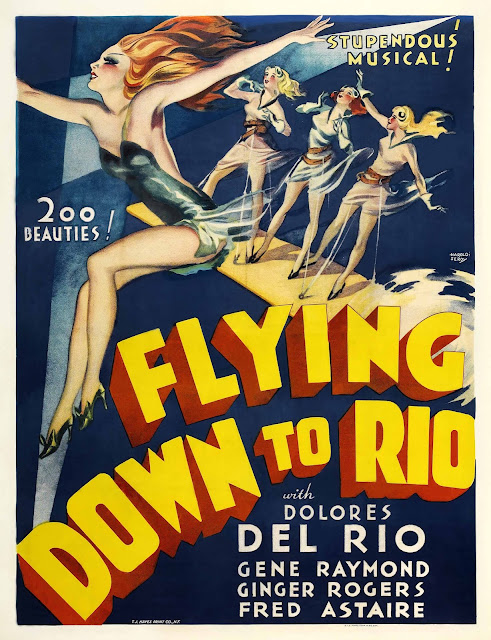 |
| 22-year-old Ginger Rogers in Flying Down to Rio (1933) |
She became a star in silent pictures and easily made the transition to "talkies." At the height of her career she married M.G.M. art director Cedric Gibbons, one of the most influential men in Hollywood. They became one of the in-crowd couples in the party circuit. She swam nude in Bird of Paradise (1932) with Joel McCrea. She danced in Flying Down to Rio with Fred Astaire and in Wonder Bar (1934) with Al Jolson. She was accused of promoting communism by attending a special screening of ¡Que Viva México! (1934), a Mexican film directed by Sergei Eisenstein. In her career she acted under the direction of Raoul Walsh, Busby Berkeley, King Vidor, Edward Dmytryck, and John Ford. In 1940, she and Orson Welles divorced their spouses and moved in together. She worked with acting coach Stella Adler. She was a friend of Diego Rivera and Frida Kahlo.
🌎 🌎 🌎
In 1933, Fred Astaire was finished with dancing partners. He had danced with his sister Adele for 27 years, first appearing in a school production when he was 5, then dancing together in stage musicals across the country, and finally dancing on Broadway and London's West End. When Adele married in 1932 and broke up the act, Fred took it hard. But a year later he was eager to embark on a solo career.
He signed a movie contract with RKO after an unimpressive screen test. Now lost, the producer who watched it wrote a memo that said of Astaire, "Can't act. Can't sing. Balding. Can dance a little." He was immediately lent to M.G.M. where he danced with Joan Crawford in the drama, Dancing Lady (1933). When he returned to the RKO lot, he was assigned work in a romantic farce starring Dolores del Rio. In the role he would engage in comedy banter with someone named Ginger Rogers, and near the end of the movie he would dance with her.
When production on Flying Down to Rio wrapped, the cast was relieved. The film looked as if it were going to be a stylistic mess and a bomb with audiences. Little did anyone know, but the movie would become a hit, mostly on the coattails and high heels of Astaire and Rogers, with their one dance number and their onscreen chemistry. Audiences had gone to the movie to see Dolores del Rio but they returned to the theater to see Astaire and Rogers again and they told their friends about the pair as well. Word-of-mouth made Astaire and Rogers the stars of the movie despite their fourth and fifth billings.
Afterward, Astaire wrote his agent that, although he was willing to make another movie with Rogers, this "team" idea was out of the question. As we all know, he relented.
Meanwhile, critics praised Rogers's and Astaire's work in Flying Down to Rio, and the audience response was overwhelming. Soon they made their second film together, The Gay Divorcée (1934). It was nominated for five Oscars, including Best Picture. Their third film together, Top Hat (1935), was nominated for four Oscars, including Best Picture. Both movies have been added to the National Film Registry, overseen by the Library of Congress.
🌎 🌎 🌎
Flying Down to Rio is pre-Code. Enforcement of the Hays Code didn't even begin until 1934. Meanwhile, producer Lou Brock, writers Cyril Hume, H. W. Hanemann, and Erwin Gelsey, and costume designers Walter Plunkett and Irene took full advantage of the rather liberal and unwritten rules while they lasted.
In one scene, a dozen women are standing on top of the wings of a propeller plane as it is supposedly flying into Rio de Janeiro for a landing. All of them are skimpily-attired and their tops are see-through. In another scene, Belihna de Rezende (del Rio) is seated at a table with three friends. One of them, jealous of the way men fawn over the local women, asks, "What do these South Americans have below the equator that we haven't?" In yet another scene, after having watched a dozen pairs of Brazilian dancers in a sultry number that included the men and women dancing with their foreheads touching, Fred (Fred Astaire) says, "That's the Carioca." Honey Hale (Ginger Rogers): "What's with the foreheads?" Fred: "Mental telepathy." Honey, looking at the men: "I can tell what they're thinking about from here."




